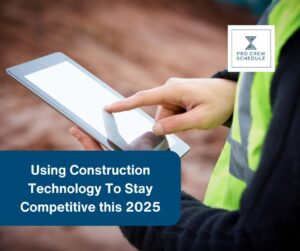The construction industry is currently undergoing a massive transformation. The continuous rise in the need for construction services increases the number of projects, complexity, and length that construction companies may be handling simultaneously. As a project manager, you may feel the stress and pressure as you cope with the increasing expectations and responsibilities to deliver exceptional projects within the client’s budget, timeline, and quality standards. However, with the availability of today’s modern construction solutions and digital innovations, managing construction can be more efficient, streamlined, and optimized by embracing construction technology and incorporating them throughout the project duration.
By embracing construction technology in its entirety, the industry can experience incredible productivity, efficiency, and safety increases. The advancement opportunities in these areas are enticing for general contractors and subcontractors, whose teams can benefit significantly from using more on-site technology: getting rid of all those inefficiencies and breaking the barrier of miscommunication between office and field. The industry is expected to expand further in the coming years, and advances in construction technology will make it easier for managers, contractors, and subcontractors to meet demand without compromising quality.
However. with decades of tried-and-true methods and traditional techniques, the construction industry is not always quick to adopt new technologies. Many construction companies are hesitant to jump on new bandwagons when they already have established processes that appear to be working perfectly. Let us look at the different types of construction technologies and how they can help with project management in this article.
What is Construction Technology?
Construction technology is the set of tools, machines, modifications, software, and other items utilized throughout the construction phase to enable innovations and optimizations in field construction methods, such as semi-automated and automated construction equipment.
Construction technology is becoming a more significant part of the industry’s future. Given the skilled labor scarcity, stagnating productivity, and safety concerns that afflict the business, it is essential to approach every project with innovative solutions and cutting-edge technologies.
7 Types of Construction Technology That Can Optimize and Streamline Your Project
In this section, we have listed down ten of the construction technologies that you should consider using to optimize and streamline your project management. Some of these technologies are relatively new in the industry. In contrast, the others have been available for several years but have recently been improved and modified better to meet the demands of the project managers and contractors.
1. Big Data
Big data refers to large data sets that can be used to find hidden trends, patterns in behavior, and unknown relationships to make better business decisions. These data can also serve as the automation systems by keeping track of every intricate detail of the steps needed to complete a project. This valuable information can be obtained through Internet searches and services, mobile phones, digital pictures, social media, and other digital communication methods. In construction, big data can be used to analyze and review patterns, risks, or probabilities to make sound business decisions and strategies based on past experiences. Data such as weather patterns, traffic movements, and business activities can be analyzed to determine optimal scheduling management.
2. Artificial Intelligence (AI)
Artificial Intelligence (AI) is machine intelligence that mimics human behavior, in which statistical approaches enable a computer to learn from data and be able to predict its next moves. In construction, AI is often used to automate highly repetitive and laborious tasks, significantly boosting productivity and time management throughout the project. Another use for AI is through predictive design, which can consider various aspects such as weather, location, and other pertinent information in the construction plans, leaving little to no room for human error and inefficiencies. This technology is already commercially available and is helping to progress construction technology by allowing the industry to benefit from its limitless potentials and responsibilities.
3. Computer-Aided Design (CAD)
For a long time, computer-aided design (CAD) has been utilized in design and construction. CAD has largely replaced manual drafting among engineers, architects, and construction managers. It has been used to make two- and three-dimensional models of possible buildings, units, and other structures. With today’s digital solutions, drawings and plans can now be accessed and stored online. As a result, every stakeholder can access CAD-based designs and programs on the job site. The contractors, subcontractors, and construction crews can immediately review plan adjustments regardless of where they may be.
4. Building Information Modeling (BIM)
Building information modeling (BIM) is the process of creating and managing digital representations of a location’s physical and functional properties. It offers a wealth of data that can be used to make decisions within the model by having a clear overview of your architectural, structural, and other systems. Using BIM reduces the possibility of change orders and increases field communication and collaboration. BIM is easily accessible and can be downloaded into mobile devices, reducing the need for massive paperwork and document mishandling ensuring smooth and seamless project management for construction.
5. Virtual and Augmented Reality
Virtual and augmented reality are often linked with the gaming industry, but they have expanded their potential and are now being used in construction. Virtual reality (VR) refers to a fully immersive experience that blocks the physical world, whereas augmented reality (AR) involves adding digital elements to a live view. When used in conjunction with BIM technology, you can generate a lifelike model of the structure and virtual walk-throughs of the building models to understand what the finished physical project will look like and how the design will flow.
6. 3D Printing
3D printing involves injecting or extruding material onto a platform with a digital model to create a three-dimensional object. In construction, 3D printing is often used to analyze any possible material change orders and how it would work with the existing specifications and specifications. This technology avoids material waste and saves time by manufacturing samples or entire products in 3D and ensuring that all features are appropriately developed.
7. Construction Scheduling Software
Construction scheduling software has proven time and time again how valuable and essential it is to manage construction projects effectively and efficiently. This software can provide contractors and subcontractors with construction crew, scheduling, and inventory management. Utilizing software can make project management, accounting, and estimating easier to manage regardless of the number or complexity of the projects, making it more profitable and productive.
5 Ways Construction Technology Can Help the Industry Move Forward
When utilized the right way, construction technologies can significantly give you a competitive advantage and increase the chance of delivering a smooth and stress-free construction experience to your stakeholders. In this section, we have listed five ways construction technologies can help the industry move forward.
1. Get Real-time Visibility Across Your Organization
Using a desktop computer to update and email a spreadsheet to someone in the field might result in out-of-date project schedules, incorrect decisions, and delays. Today’s construction crews must be able to update a project’s status from afar, always keeping everyone up to date. You may receive a real-time overview of what’s going on in your project with construction software. With this vital information, you can quickly identify possible difficulties or hazards and strategize before they become a bigger problem.
2. Automate tedious and repetitive tasks
Days and weeks of delays can be added up from minutes and hours squandered on a job. Because one part of a project must typically be completed before the next can begin, progress is often delayed as people wait for information or approvals. Companies may automatically ensure that their projects move forward by using a work execution platform to establish automated systems such as warnings, collect digital signatures, and maintain up-to-date project documentation.
3. Ensure Open Communication and Close Collaboration
Tasks are unnecessarily delayed, and mistakes are made when team members work separately. As a result, project managers and construction crews must work together by keeping open communication and close collaboration throughout the project. While mobile devices can significantly increase communication, construction firms must also develop systems that facilitate real-time collaboration to achieve maximum efficiency. Using a cloud-based platform, you can easily handle work management, enable collaboration between employees, contractors, and clients, automate approvals and alerts to create a more efficient operating process.
4. Smarter Cost Allocation
Technology can have a direct, observable impact on your site’s costs. It’s simple for costs to mount in the construction industry:
- A tool goes lost.
- A machine requires more gasoline.
- A few team members work overtime.
Using technology to measure fuel use, maintenance requirements, and work hours can save your project a lot of money.
5. Safer Workplaces and Jobsites
At building sites, safety has always been paramount. Contractors can use technology to make workplaces safer for crews in a variety of ways. Telematics can be used to track equipment and perform as-needed repair, ensuring that site workers are constantly working with top-of-the-line equipment. Team leaders may also identify what equipment is routinely breaking down, signaling that it may need to be replaced, with all this maintenance data readily available. This can help avoid significant equipment failures, which can be hazardous to workers.







